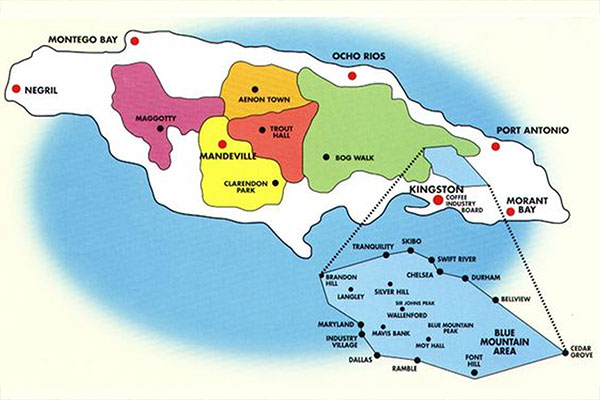
The Perfect Climate produces exotic coffee
Nestled among the clouds, where the air is as pure as the water is crystalline, lies the heartland of the world-renowned Jamaica Blue Mountain coffee. This coffee, revered by connoisseurs and casual drinkers alike, owes much of its exceptional quality and unique flavor profile to the distinctive climatic conditions of the Blue Mountains. In this post, we’ll delve into how these conditions craft the perfect cradle for cultivating one of the world’s most sought-after coffees.
The Blue Mountains: A Natural Greenhouse
Rising to heights of up to 7,402 feet (2,256 meters), the Blue Mountains stretch across the eastern portion of Jamaica, creating a natural barrier that shields the coffee plantations from the harsh tropical sun. The higher elevations, particularly those above 3,000 feet, are where the magic truly happens. Here, the climate is a delicate balance of factors that coffee plants adore.
Temperature: A Gentle Embrace
One of the key climatic conditions that set the Blue Mountains apart is the temperature range. The area benefits from a cool, almost temperate climate, unusual for a tropical island. Daytime temperatures hover around 73°F (23°C), dipping to a cooler 60-65°F (15-18°C) at night. This cooler climate slows the coffee beans’ ripening process, allowing them to develop more complex sugars and, consequently, a richer flavor profile. The beans mature slowly, absorbing and integrating the full spectrum of flavors offered by the soil and surrounding ecosystem.
Rainfall: Nature’s Perfect Timing
The Blue Mountains receive a generous amount of rainfall, averaging between 70 and 200 inches annually. This rain is not merely about quantity; its distribution throughout the year plays a crucial role. The rainiest periods align with the coffee plants’ growth cycles, providing ample water during the flowering and cherry development stages. The mist and cloud cover associated with these rains also play a critical role, protecting the coffee plants from potential sun damage and ensuring the leaves retain moisture, a vital factor in the slow maturation of the coffee cherries.
The Mist: A Veil of Protection
A quintessential feature of the Blue Mountain climate is the persistent mist that envelops the region. This natural veil serves multiple purposes: it moderates the temperature, ensuring it remains steady and cool; it acts as a barrier against the direct sunlight, diffusing the light to a soft glow that the coffee plants thrive under; and it maintains a high humidity level, which is crucial for the coffee’s slow growth process. This misty condition creates a greenhouse effect, fostering an environment where coffee beans can develop their full potential.
Soil: The Foundation of Flavor
While not a climatic condition per se, the soil of the Blue Mountains is an essential part of the terroir that shapes the coffee’s character. The volcanic soil, rich in minerals and exceptionally fertile, provides a robust foundation for coffee plants. It drains well, yet retains moisture, offering the perfect balance for root development. This fertile ground, combined with the unique climate, contributes to the nuanced flavor profile of Blue Mountain coffee.
A Climate-Crafted Masterpiece
The climatic conditions of the Blue Mountains are a serendipitous blend of elements, each contributing to the cultivation of a coffee bean unmatched in flavor and quality. The cool temperatures, ample rainfall, protective mist, and fertile soil converge to create a natural hothouse where Jamaica Blue Mountain coffee can flourish. The result is a coffee that is not just consumed but experienced, offering a taste that is as rich and complex as the climate from which it springs. In every sip of Jamaica Blue Mountain coffee, one can taste the symphony of climatic conditions that have harmonized to produce this exquisite brew.






